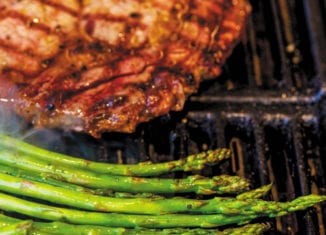Cabernet and chardonnay for summertime parties
By Bob Lipinski
With winter a faint memory and spring rapidly disappearing, the “dog days of summer” will soon be upon us. It’s party and barbecue time for all summer’s holidays and special events. Now even though I generally drink more white and rosé wines in hot weather, there’s nothing like a chilled glass of chardonnay or a large, bowl-shaped glass filled with a full-bodied cabernet sauvignon.
When pairing food to wine remember that wine is constant, and you can’t change what’s inside the bottle. But you can change the ingredients, texture or flavor of the finished dish to complement the wine. With an oaky, buttery, somewhat toasty chardonnay, I generally look for foods that share some of the same taste components. Examples might be fish cooked in or served with some drawn butter like lobster, steamers, scallops and crab; or fish that has seen time on the grill or in the broiler and its top is nicely toasted or browned. Salmon is another winner because of the rich, buttery texture, which pairs nicely with chardonnay. Fish contains oil and wines (white and red) with good acidity cut the fat in seafood. Think for a moment why you add lemon juice to fish — to balance the oils. (If you said because it lessens the fishy smell or taste, you are eating old fish.)
Tip: If you really want to serve a full-bodied red wine with a medium-well or well-done piece of meat, immediately brush the meat with extra-virgin olive oil when the cooking is complete and spoon over diced tomatoes that have been marinated with extra-virgin olive oil and lightly anointed with lemon juice.
Full-bodied red wines like cabernet sauvignon are a natural for heavier, full cuts of meat, like steak, ribs, veal or pork chops. However, a full-bodied red wine served outdoors during an afternoon barbecue in August tastes horrible when its internal temperature reaches 85°F. Warm red wine feels heavy in the mouth. The heat accentuates the alcohol and makes the wine appear flabby and makes the acidity seem to disappear. So, simply chill the wine for around 30 minutes before serving or place into a chiller (minus the ice) and place on the picnic table.
When pairing red wine to meat, it’s important to know how your guests like their meat cooked. We know that rare is juicy with succulent flavors, and at the other end of the spectrum, well-done is dry with little or no juice. A young, dry full-bodied red wine (cabernet sauvignon), which is often loaded with tannins (causes your mouth to pucker), dries your mouth and is probably not suited to meats cooked longer, but is perfect for juicy rarer cooked meats. So with well-done meats choose a fruitier red (pinot noir) and with rarer cooked meats choose a fuller-bodied red (cabernet sauvignon).
Barbecue is 25% inspiration and 75% perspiration.
That’s it for now; just remember to save a seat for me.
Bob Lipinski, a local author, has written 10 books, including “101: Everything You Need to Know about Vodka, Gin, Rum & Tequila” and “Italian Wine & Cheese Made Simple” (available on Amazon.com). He conducts training seminars on wine, spirits and food and is available for speaking engagements. He can be reached at www.boblipinski.com or [email protected].







